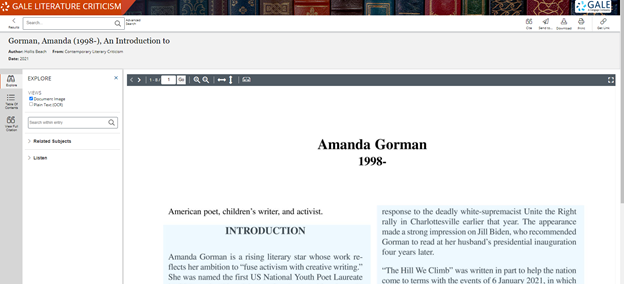| By Jennifer Stock |
In January 2021, Amanda Gorman took the stage at President Joe Biden’s inauguration to recite her poem “The Hill We Climb,” voicing hope for “a country and a time where a skinny black girl descended from slaves and raised by a single mother can dream of becoming president, only to find herself reciting for one.” At just twenty-two years old, the youngest inaugural poet in American history became an inspiration to young people across the nation.
Melissa Alter Smith was one of many educators who quickly incorporated Gorman’s inaugural poem into their lesson plans. “I love what Amanda Gorman did right now for poetry. She just brought it and made it into this huge thing that kids are excited about,” Smith said in a KQED interview. Smith, who teaches at a charter school in North Carolina, is the founder of #TeachLivingPoets, which aims to help educators expand the literature curriculum to include contemporary poets, along with the classic canon. Smith explains: “I admit I was one of the teachers who stuck pretty much to canonical poetry: Frost, Whitman, Dickinson. And not to say we should not teach those; I think we absolutely should. #TeachLivingPoets is not about closing the door on the canon whatsoever. It’s just about opening the door wider for more voices, more contemporary voices to come into our classroom space.”
There are many benefits to “opening the door wider” to include contemporary authors in the curriculum. Much of the classical literary canon is Eurocentric; Black, indigenous, LGBTQ, and other diverse voices are largely underrepresented or missing. Students suffer from the lack of representation of their own heritage and experiences. When the books you read in school are rarely written by authors who share your heritage, it’s disheartening and disengaging.
When literature represents diverse perspectives, readers can imagine themselves in someone else’s story, sharing and learning from experiences that differ from their own. At the same time, students want to read works they can identify with, from authors who share their own history and culture. As Smith summarized in the KQED interview, the study of contemporary poets “offers a lot of students a chance to not only see themselves reflected in the work that they read, but to learn, too, often about others who are different than us.”
Teaching living poets provides a more inclusive, diverse experience for students. It can also increase student engagement. The poets in the traditional canon were the voices of their time, but many students find it difficult to connect with poets of the past. However, students can relate to contemporary poets like Amanda Gorman, who speak to the issues that students are facing in their own lives. Furthermore, living poets can inspire students to find their own creative voices.
Gale’s Contemporary Literary Criticism series, which features introductory essays along with critical responses to the works of contemporary authors, is an excellent source for the study of living poets and authors. Since it often takes time for critical opinions to be published about emerging authors, the series editors have recently decided to include brief entries on significant, new authors whose work has not yet generated a breadth of critical response. This approach promptly serves students and educators interested in current literary works. Contemporary Literary Criticism, Volume 486, available online via Gale Literature Criticism, is the first volume to feature this new, brief entry on emerging authors, with an entry on Amanda Gorman.
Gale Literature Resource Center also supports the study of contemporary poets. Some examples include:
- Natalie Diaz, a Latina and Mojave American poet who won the Pulitzer Prize in 2021
- Ross Gay, author of the best-selling poetry collection The Book of Delights
- Vietnamese American poet Ocean Vuong
Gale resources are here to support your efforts to teach living poets and provide a more inclusive experience for students of literature.
Meet the Author
Jennifer Stock is a senior content developer at Gale, a Cengage Company, where she has worked on a variety of projects, including eBooks and electronic databases, for K‒12 and academic audiences.


